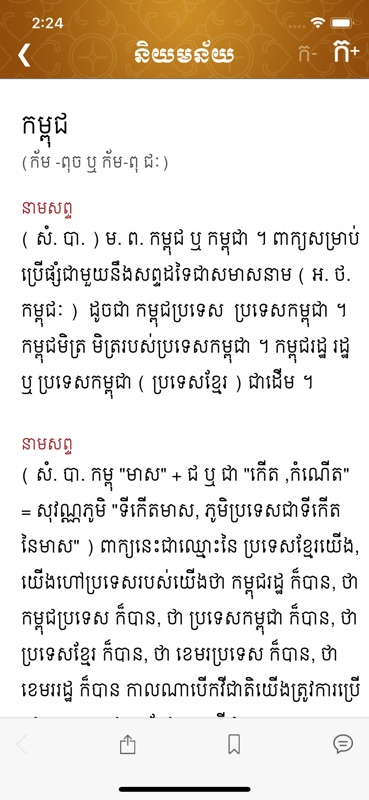Bornon 11 March 1883 into a farmer family, Chuon Nath was the elder of two sons. Hewas named as Nath and his family name is Chuon. They lived in Kompong Spueprovince located on the South-West of Phnom Penh, Cambodia. A miracle hadhappened before his mother Yok waspregnant. In her dream, she saw a person dressed in white descending from themoon and bringing a yellow sapphire ring to offer to her. Then the followingmorning, she was told they would have a son with a long life. Further, Yok was different from other pregnant women because she preferredto eat ripened pineapples rather than usual mangoes preferred by the mostpregnant women.[1]

The new dictionary is based on the Khmer-to-Khmer dictionary Chuon Nath compiled from 1915, and contains 18,003 Khmer words. It has taken 17 staff over two years to computerise the dictionary, in cooperation with the Open Institute, SEALang and the Cambodia National Language Committee. Samdech Chuon Nath ជួន ណាត Chuon Nath Som Dech Nath was the head of a reformist movement in the Khmer Buddhist Sangha which developed a rationalist-scholasti. In 1969, he succeeded Chuon Nath as the new Supreme Patriarch of the Maha Nikaya order upon the latter's death. 1 On 17 April 1975, immediately after the Khmer Rouge 's march into Phnom Penh, Hout Tat and all the Buddhist monks were ordered to leave the city.
In1897 he became a novice monk (Sāmanera) and received his upasampada (bhikkhu) in 1904 when he turned 21years old. It was until 1899 that Chuon Nath started to be seriously engaged inmore academic studies after he and his only brother Chuon Nuth moved to PhnomPenh to pursue higher education. Since 1902 he was very active in both hisstudies and work. In 1922 Chuon Nath and venerable Huot Tath went to study at FrenchSchool: École française d’Extrême-Orient (EFEO) directed by Louis Finot(1864-1935) in Hanoi, Vietnam. While theywere studying there they came into contact with another French director SuzanneKarpeles (1890-1969) who worked together with Louis Finot at the school. I willbe discussing Karpeles’ important role in modern Cambodian Buddhism and theBuddhist Insitute in next chapters. Ontwo different occasions, Chuon Nath and his close friend Huot Tath attended thecourses on Sanskrit and ancient inscription of Khmer literature originated inthe walls of the ancient temples acrossCambodian, at the EFEO.[2]Probably because of this course that made Chuon Nath become the Khmerliterature scholar and the author of the Khmer dictionary. The death of ChuonNath on 25 September 1969 was a big lossfor Khmer society and greatly missed by many Cambodians, who have not been ableto find someone of Chuon Nath’s stature since then. In a graceful manner to the patriarch, the image of ChuonNath was covered on the front page of the KampucheaSuriya issued in September 1969.

Samdach Chuon Nath In Khmer
“We are the Kampuchea Suriyamagazine, Buddhist Institute, and allstaff would like to express our deep sadness over the loss of the mostrespected venerable scholar.”[3]
In his honor, the vast commemorative was held in Phnom Penh in1970. For many years his name was not known. Following the end of the Civil Warin the late 1970s, Chuon Nath re-emerged in the late20th century. His anniversary was upheld each year in the 21stcentury.[4]
Apart from being a scholar monk, he was an author, poet, and composer. He was the founder of the modernKhmer Dictionary and the composer of the Nokor Reach (national anthem) as wellas the Cambodian Buddhist flag hymns. Besidesthe Khmer language, he was capable ofcommunicating in such languages as French, Thai, Vietnamese, Lao, and English as well as his profound Pali andSanskrit. It was proof of his linguistcapacity when he was at thefirst General Conference of World Fellowship of Buddhists (WFB) in Colombo, SriLanka, which I will discuss in chapter three. From the year 1930 until his death, he received many titles and honors for his services for Cambodian societyincluding in the context of Buddhism, education, culture, social welfare, andacademic scholarship in addition to his award of honors from foreign countriessuch as Burma, Lao, and France. For all theinformative aspects on these matters, you will find in the following chaptersand appendices. More important than this was the contributions made by ChuonNath during his hardworking and tireless effort. He had to face a lot ofcriticism in his attempt to promote so-called the modernist Buddhism. However, in the end, his works were respectfully recognizedand accepted. His modernist idea of Buddhism was similar to the conceptmentioned in the work by David McMahan.[5]During and after the French Protectorate in Cambodia for 90 years (1863-1953), ChuonNath was involved in social activities. This socially-engaged movement wasquite like the demonstration shown in.[6]
[1] ChhoemSom. ព្រះរាជប្រវត្តិពិស្តារ និង កាព្យលោកធម៌របស់សម្តេចសង្ឃរាជ ជួនណាត ជោតញ្ញាណោBravattipisdea ning Kabylok-thormRobas Samdech Sanghareach Chuon Nath Chuotanheanou [TheDetailed Biography and Worldly-eight Dhamma of Samdech Sanghareach Chuon Nath Choutanheanou], 1970.
[2]HarrisIan, Cambodian Buddhism: History and Practice, 2005, pp.116, 119.
[3] Ly Theam Teng ed. ទស្សនាវដ្តីកម្ពុជាសូរិយាKambuchea Suriya (Sep 1969), 2nd ed. 20 Feb. 1970, and thismagazine was published monthly by the Buddhist Institute and Chuon Nath wasalways one of the usual authors.
[4] “The 37th anniversaryof Chuon Nath in 2005”, accessed October 12, 2018, https://www.youtube.com/watch?time_continue=40&v=cDtlzyiwX30. Watch this video with Englishsubtitle for better understanding about Chuon Nath.
Chuon Nath Khmer Dictionary
[5] David L.McMahan, ed. Buddhism in theModern World (New York:Routledge, 2012), ch.8.
Samdech Chuon Nath
[6] Ibid.,ch. 10.
